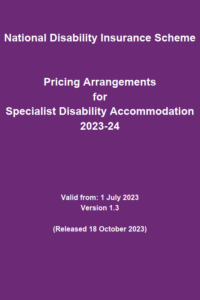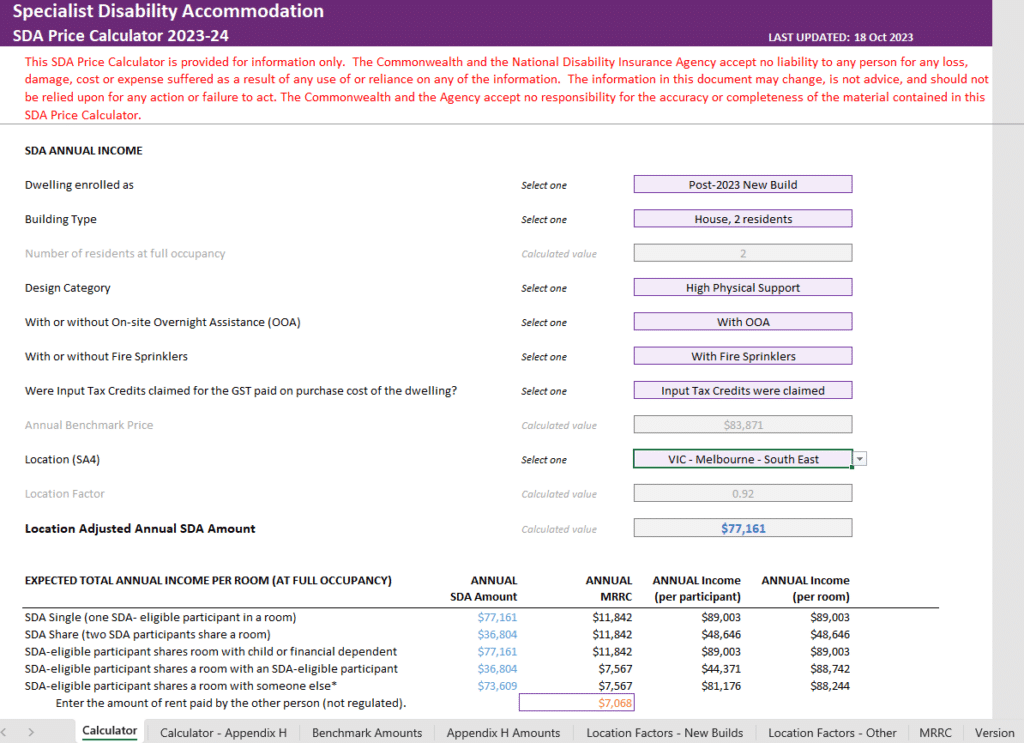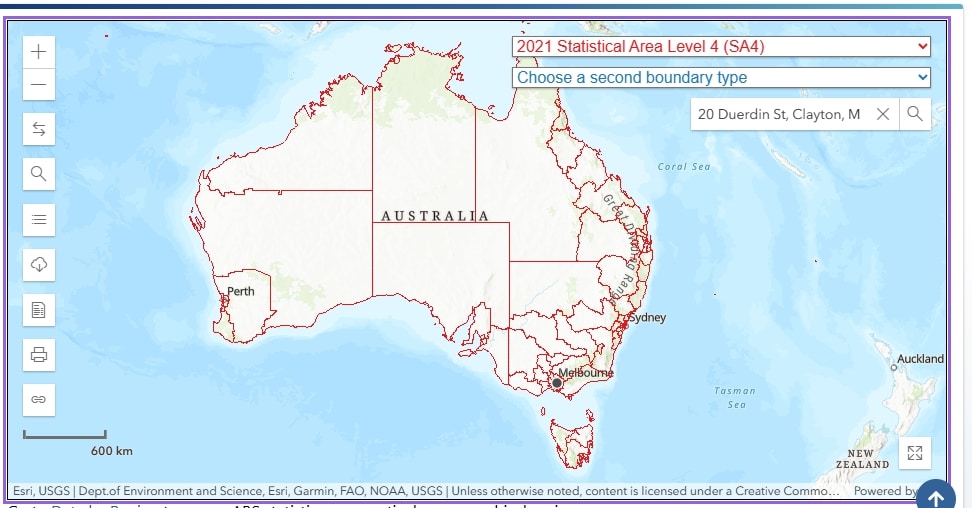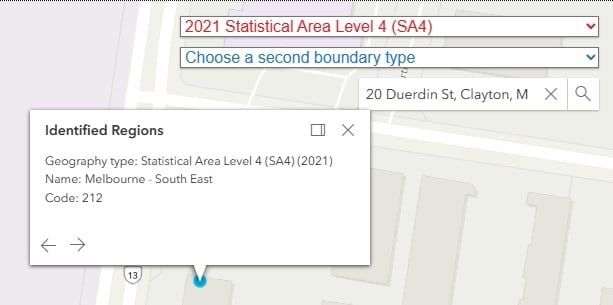-
1300 994 890Property Management1300 832 373Consulting & Certification
How much money will I earn investing in SDA Specialist Disability Accommodation?

What Financial Returns Should I Expect with SDA
One of the most asked questions from people wanting to invest in SDA or Specialist Disability Accommodation is, ‘How much money will I make? I have heard it is a lot”. This is followed by, “I heard the payments are Government guaranteed,” and then “Where should I build an SDA?”
All three questions miss the point of providing SDA that is Desirable™️ to participants.
Where Should I Build SDA
This is one question we will not answer. It is not a case of building SDA; participants will queue up to move in. It is now becoming a competition for the best and most desirable SDA to attract participants.
- Is it near community facilities, retail, and medical, or is it located in an area that was once a cow paddock a couple of years ago?
- Is there public transport available?
- How many people will be expected to live in the dwelling, 1, 2, 3, 4 or 5?
- Will each participant have an en-suite?
- Will the dwelling meet the minimum SDA requirements, or does it go well above?
- Height adjustable kitchen benches and cupboards
- Height adjustable bathroom basin/ vanity
- Full home automation
- Hoist system (HPS) between bedroom & bathroom
- Does it feel warm and welcoming?
- Is there an al-fresco area for socialising, BBQs etc?
Demand
- However, the most crucial question is, “Is there a demand for SDA in this location? We are already seeing pockets around Australia where there is an oversupply of SDA whilst other areas are screaming out of SDA.
Demand Analysis
We are not experts in demand analysis. SDA Consulting’s expertise includes design advice, SDA certification, and registration. We are also specialist SDA Property Managers. However, we stress this is the most critical step in developing SDA and must be undertaken before putting pen to paper.
Many of our clients use PPC Urban, experts in this field.
Another option to know what is already available and in development is to search the Housing Hub website. They also prepare property demand reports.
If you contact either of these organisations, please let them know how you found them. Thank you.
Participant Demand
Closely aligned with finding participants for sub-standard SDAs is the number of participants you will successfully attract. Some examples are:
- Building a two, three or even a four-bedroom Robust SDA. From experience managing a significant number of Robust dwellings, we know that it is most likely only one participant will be able to be accommodated due to behavioural issues, including triggering, aggression and violence, as well as damaging behaviour. This means you will have empty bedrooms that cannot be used or claimed for payments. I just searched and was shocked to see companies still spruiking two participants Robust with 15%+ returns – Good Luck!!!
- Building a two-, three- or even four-bedroom HPS/FA dwelling where participants are expected to share a bathroom. Would you want to share a bathroom with a stranger? But hey, for three participants sharing one bathroom, you will earn an amazing 15%+ return – Again, Good Luck!!!
- How about a three-participant home, each with its own bathrooms but only one living/family space? So, as a participant, you can stay in your bedroom or go out to a single space where the TV and other participants will be. What if you want to chill, read a book, or catch up with family and friends but have nowhere to go? Do people understand how big a motorised wheelchair is, typically used by HPS participants? But hey, you will get a 20%+ return, dare I say again, Good Luck!!!
No Participants = No Money
Government Guaranteed Payments For SDA
Answering the second question next, the answer is No, it is not government guaranteed, which is followed up with, “but we have been told by other builders, developers, and investment advisors it is. So, to set the record straight, It is not. You will only receive payments if someone is enrolled to live in your SDA. No people = no money.
Participants will not want to move into the dwelling if your house is not well-designed, spacious, welcoming and desirable. Too often, we see cheaply built SDAs, badly designed and poorly finished in unsuitable locations where we cannot find participants.
How Easy Is It To Find SDA Participants?
Finding participants and enrolling them in an SDA can take anywhere from two months to twelve months or more for low-demand or over-developed areas.
This is not a simple process as with standard rental houses; it is far more complex, especially considering the number of parties involved, including guardians, parents, allied health representatives, etc.
The following is an example of a phone call our property managers receive from people who invested in SDA and have not done their due diligence and understand how an SDA is delivered.
So my house will be finished in two weeks. Can you organise participants to move in then?
Karina Ces (Director in charge of property management) and Nicole Matejka (Senior SDA Property Manager) with SDA Consulting were interviewed twice by Debbie from SDA Housing. They discussed all aspects of SDA property management, from enrolling and managing properties through to sourcing participants.
EPISODE 171 – SDA CONSULTING GROUP: Property Management (1/2)
In this initial episode, Debbie is joined by Karina and Nicole from SDA Consulting Australia. Karina and Nicole discuss the roles of an SDA Provider as a Disability Property Manager. Nicole is a property manager with over 18 years of experience, so she looks at the process very much from the property management perspective.
They discuss the modifications and additional requirements needed by individual participants over and above the standard provisions in the property. Many of these modifications may need to be paid for by the property owner, particularly if they wish to secure a particular participant as a tenant; however, some additions are funded by the SILs or can be funded through the participant’s plan.
They discuss the fact that all SDA-funded participants have to fit into one of 4 broad SDA categories, and given the vastly different needs and requirements each individual will have, it is understandable that additional modifications might be needed to ensure the home is suitable for the participant’s needs.
The ladies also discuss the SDA property certification and enrollment process to ensure a property is registered with the NDIA and is ready to be tenanted by NDIS Participants, as well as the sourcing of participants and the various stakeholders involved in assessing the home for suitability and any modifications required, along with participant matching for multi-tenant homes. The potential vs. actual incomes a property owner may receive are discussed regarding the funding a participant has as opposed to the funding level the dwelling has been enrolled for.
The challenges for everyone involved are covered from funding levels, expectations of income by owners, separation of supports and communication between the various stakeholders. Karina and Nicole finish by explaining the fantastic difference to a participant’s life that moving into an SDA home can result in – which, at the end of the day, is the primary reason for Specialist Disability Accommodation.
Episode 188 – SDA CONSULTING GROUP – Property Management (2/2)
As a follow-up to Episode 171, this is Part 2 of 2 with Karina and Nicole from SDA Consulting Group. Technically, it is Part 3 of 3 if you include Episode 160 with Bruce Bromley 🙂
This episode has Debbie sitting down for another chat with Karina & Nicole to discuss in more detail the role of an SDA Provider and SDA Property Manager when wearing both hats. There seems to be a lack of “property management” experience in the SDA provider space across this industry, and we thought it would be worth the effort to delve into greater detail about the subtle differences compared with other SDA providers. The process of enrolling a property as an SDA dwelling and how Participants are sourced are discussed. The intricacies of the different types of dwellings, locations and participant funding are highlighted as reasons why it may take longer to tenant some properties.
The ladies also discuss what they offer to the industry as licenced property managers in addition to SDA providers and how many different stakeholders are involved behind the scenes when it comes to looking after properties, ensuring it’s set up and ready for the tenants and that all the paperwork has been looked after and is in place. As always, we are ever grateful for the support from industry experts like that seen with the SDA CONSULTING GROUP, and we value their contributions in trying to “do good” for all stakeholders.
How to Calculate the Payment amount for providing SDA
Now, to answer the first question on investment returns, this is a reasonably simple process.
- Firstly, download the Pricing Arrangements document. Refer to Step 3 here.
- Secondly, download the NDIS SDA Price Calculator Excel file on the same page.
Calculator
The calculator has multiple fields that need to be selected. Thankfully, they are mostly self-explanatory except for the Location Factor SA4.
What is Location SA4?
Statistical area level 4 (SA4) is one of the spatial units defined under the Australian Statistical Geography Standard (ASGS). The ASGS is a hierarchical geographical classification defined by the Australian Bureau of Statistics (ABS), which is used in the collection and dissemination of official statistics. The ASGS provides a common framework of statistical geography and thereby enables the production of statistics that are comparable and can be spatially integrated.
How do I work out my location within the calculator as required?
- Please go to https://maps.abs.gov.au/
- From the red drop-down box, select 2021 Statistical Area Level 4 (SA4)
- Then, enter the address of the property you are considering and click search.
- The search result map will be displayed.
- Click near your property, and a window will appear below.
- Beside Name: is the SA 4 Location name you must select in the calculator. In this example, it is ‘Melbourne – South East’.
- This is what you need to select from the Location drop-down box.
The calculator will now automatically calculate the expected return. Note this is the best-case scenario, and it is not always the case of what a participant has qualified for. Also, investigate the returns for Fully Accessible and Improved Liveability, as these participants may be all that will be available when the development is complete.
Again, there is no government guarantee that these amounts will be received.
Property Management
Need advice? Please get in touch with Us about the Property Management of SDA,
Bruce has over 32 years of experience in disability access, architectural design, documentation & project management
He formed Equal Access Pty Ltd in 2006 in response to growing recognition, that whilst businesses were being urged to respond to their obligations under the Disability Discrimination Act, the majority of assistance available was focused almost entirely upon the needs of the individual with a disability without an understanding of the impacts and practicalities for building owners, managers and consultants.
Bruce also specialises in evacuation procedures and policy for people with a disability and is a member of the Standards Australia development committee FP-017 Emergency Management Planning – Facilities (AS3745)








